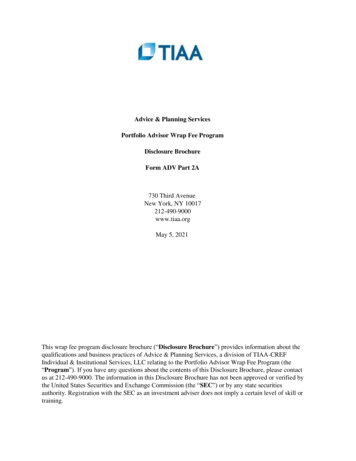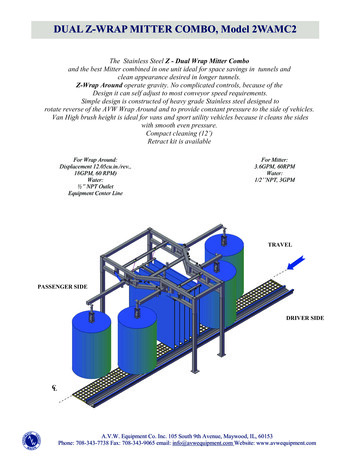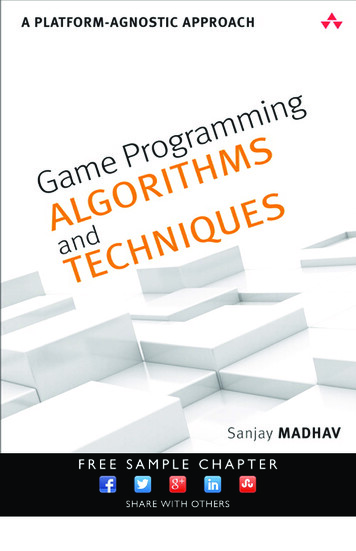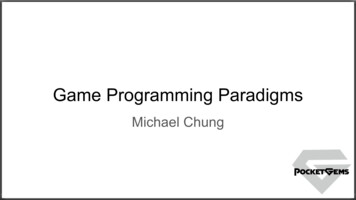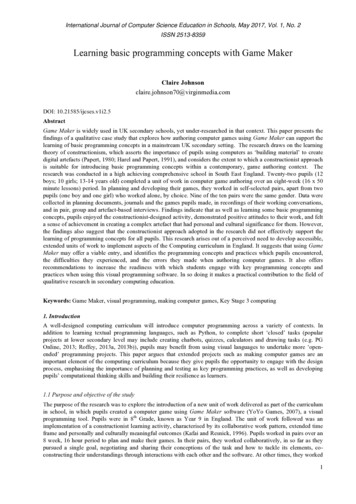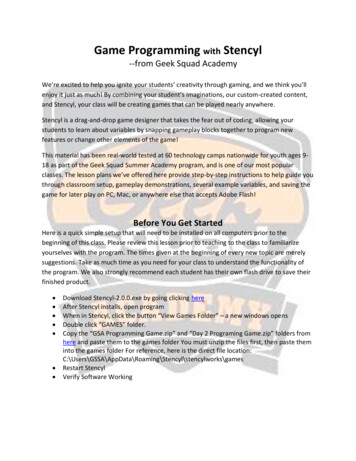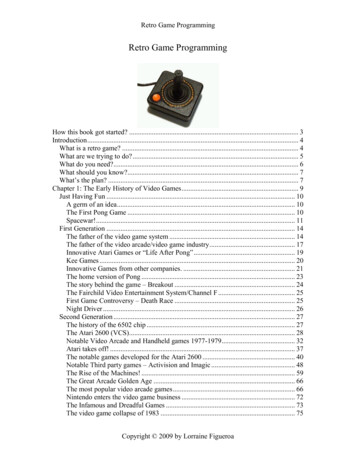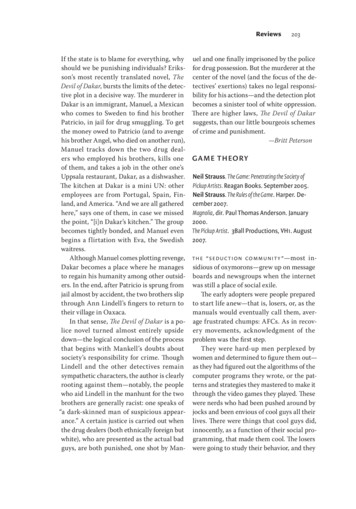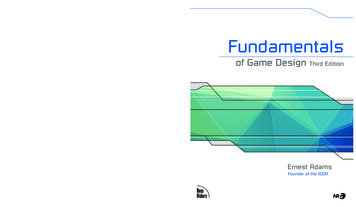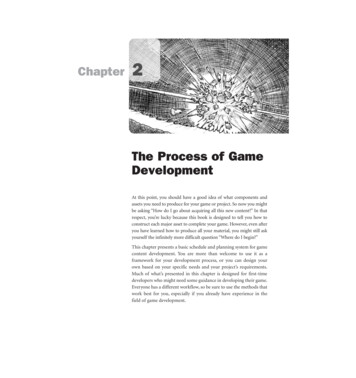
Transcription
Game WrapGame Wrap Volume 2 is Copyright (c) 2017 by NewEngland Interactive Literature. Copyrights to individualarticles and larps herein remain with their respectiveauthors.This work is licensed under the Creative CommonsAttribution-ShareAlike 4.0 International License. To viewa copy of this license, visit http://creativecommons.org/licenses/by-sa/4.0/.New England Interactive Literaturec/o Chad Bergeron258 Edgell RoadFramingham, MA 01701http://gamewrap.interactiveliterature.org
Editor’s NoteWelcome to the second volume of NEIL’s GameWrap —a publication dedicated to the art and craftof LARP. It has been a year of adjustment andchanges as we’ve worked to bring you this sophomore effort and continue to think about whatGame Wrap could be, how to realizethat vision, how to carry it throughlogistically and what role it plays inthe New England larp community andbeyond. We have expanded our staffand streamlined our process, and lookforward to more growth as we put ourefforts into supporting authors andencouraging writing about larp as acomplementary endeavor to writingand playing in larps.The landscape of larp has seen much change in thelast decade, and there is a sense of acceleration andmomentum to that growth. There has been greaterpublic visibility of LARP and its uses from coveragein the Business Insider,1 teaching LARP basics in aLexington summer camp,2 to even news of plansfor a Disney Star Wars immersive resort whereguests costume and roleplay in the stories set inthe Star Wars universe.3Larp is education, larp is in tourism, larp is news,larp is activism. At the same time it can be easy tofeel disconnected and left out of the loop of theinnovative developments in larp, if one maintainslarp as a hobby balanced against the rest of one’sobligations. I’ve felt this firsthand as I movedacross the country and plunged into a different local larp culture with its own norms and traditions.Larp publications, like all publications, can serveas a way to connect with a particular communityand more so for communities largely separated by1 Renfro, Kim. “‘Harry Potter’ fans are living outtheir fantasies at a real-Life school for wizards.” BusinessInsider, Business Insider, 23 Jan. 2016, vent-in-poland-2016-1.2 http://www.larpadventureprogram.com/3 Fickley-Baker, Jennifer. “Plans Unveiled for StarWars–Inspired Themed Resort at Walt Disney World.”Disney Parks Blog, 15 July 2017, isney-world/2geography and differing larp cultures. They are away to connect intellectually and share ideas, andfor a reader a way to learn something new.One goal for Game Wrap has been to provide suchan opportunity to share the NE larpculture and foster a cultural cross-pollination that helps develop larp as apastime and an art form. Another goal,in support of the first, is to provideanother avenue for the development oflarp culture in giving space for morelong-form and slower discussion of atopic than in the delightful spur of themoment conversations late into a conevening or even a moderated discussion at NELCO. We believe that creating this spacegives us a way to deepen a culture of reflexivity andanalysis in the NE larp community, and allows usto learn about the great variety and creativity ofthought and design behind our favorite games.It has been personally exciting to think along withone of the author’s included in this volume aboutthe work of creating “truth” within the artificeof playing pretend, to learn from another of theexperiences at Peaky Midwest about the challengesof teaching others how to write a game, to get aglimpse into the larp traditions being developedinternationally and how they tackle familiar problems of immersion and engagement in familiarand innovative ways, and to notice the wealth ofcommunity building expertise represented by allthe authors. It has also been illuminating to seehow limitations can drive creativity and how goodthings sometimes really do come in small packagesin our selection of some ingenious micro larps.Take a read through this second volume, enjoy,question, and critique. Talk to your friends. By allmeans, disagree. And then add your own thoughtsand expertise to the discussion, in Vol. 3. We atGame Wrap believe that it will enrich us all andcontinue to expand the scope of what larp can be.Viktoriya FuzaylovaGame Wrap 2017
ContentsArticlesnEditor in ChiefViktoriya FuzaylovaEditorial BoardViktoriya FuzaylovaStephen KohlerBrian RichburgPhoebe RobertsAdina SchreiberAuthor LiaisonBrian RichburgCopy EditorsTegan KehoeStacy HaponikFrom Bad to BetterLarp Design Lessons from 10 Bad LARPsby Nat Budin 7Collaboratively Written Characters andTheir Role in Creating a Successful Larpby Aliaksandra Franskevich. . . . . . . . . . . . . . . . . . . . . . . . . . . . . 11Chekov’s CrewThe use of adjunct crew in theatre-style larpsby Stephanie Pegg. . . . . . . . . . . . . . . . . . . . . . . . . . . . . . . . . . . . . 17Constructing Truth in LARP writingby Xavid (http://xavid.us/). . . . . . . . . . . . . . . . . . . . . . . . . . . . . 25No battle plan survives contactwith the enemy:The tension between narrative structure andplayer autonomy in larpby Phoebe Roberts. . . . . . . . . . . . . . . . . . . . . . . . . . . . . . . . . . . . . 30Peaky MidwestRunning a Weekend LARP Writing Workshopby Eva Schiffer . . . . . . . . . . . . . . . . . . . . . . . . . . . . . . . . . . . . . . . 36LARPSLayout DesignerKathleen De SmetRules As Writtenby Ben Klug. . . . . . . . . . . . . . . . . . . . . . . . . . . . . . . . . . . . . . . . . . 43Consensus RPGWebmasterNat Budinnby Thorin Tabor . . . . . . . . . . . . . . . . . . . . . . . . . . . . . . . . . . . . . . 43Now Listen Young Lady!by Susanne Vejdemo. . . . . . . . . . . . . . . . . . . . . . . . . . . . . . . . . . . 44The Asylum Gameby Susanne Vejdemo. . . . . . . . . . . . . . . . . . . . . . . . . . . . . . . . . . . 46Game Wrap 20173
TheArticles
From Bad to BetterLarp Design Lessons from 10 Bad LARPsby Nat BudinIntroductionThe 10 Bad LARPs series is an anthology of terrible larp ideas which run back-to-back, each for avery short time (usually either ten minutes or oneminute). The series, which includes four separateanthology games, contains a wide variety of tasteless and deliberately flawed designs, contributedby a large set of authors.I co-created the 10 Bad LARPs series in 2005 alongwith Susan Weiner and Zachariah Hauptman,with the original 10 Bad LARPs in 100 Bad Minutesdebuting at Intercon E. Along with a growing setof writers, we followed it up the next year with 10Bad LARPs: The B-Sides, and then 4 Bad LARPs in40 Bad Minutes and 10 Bad LARPs: C-Section.Every larper and larp creator has slightly differentideas about what they consider good larp design.Conversely, in a group of multiple larp authors,each will have their own views on what makes alarp “bad.” The 10 Bad LARPs series, by virtue of itsrelatively large set of writers, represents a diversityof types of “badness.”In the context of a 10 Bad LARPs game, ideas thatwould obviously never work in a full-length larp(at least in someone’s opinion) become playableand even enjoyable. Why is this? How can we applythese phenomena to the design of other larps?Game Wrap 2017MethodologyI read through each game from the original 10 BadLARPs, its sequels, and the “apocrypha” (gamesthat were cut in revisions to each of these collections). This was a total of 68 games.While reading each game, I assigned a set of “tags”to it, attempting to identify common elements. Ifocused in particular on elements that made thecontent offensive and elements that I considergenerally good and bad in theatre-style larp design,but also assigned tags for things that are commonly found in 10 Bad LARPs games. In addition,I noted the author of the game and its length inminutes.Through this process, I developed a set of categories of “badness” found in the 10 Bad LARPs seriesas well as some ways in which these flaws aremitigated.Categories of badnessFor the purposes of this analysis, I looked at elements in 10 Bad LARPs games which, if presentin most mainstream theatre-style larps, wouldgenerally be considered problems for the game’sdesign. The following categories of design flawwere identified in the tag analysis:7
Impossible goals: The game asks players toattempt to achieve certain goals, but these goalscannot be achieved. Insufficient mechanics: The game asks playersto achieve goals in opposition to other players,but this conflict cannot be adequately adjudicated given the game’s mechanics. Unsustainable premise: the conceit of the gameis too ridiculous or too unbelievable to be maintained for a full-length game. Undermines own premise: The conceit of thegame would be sustainable if not for other elements present in the design. Incoherent: The game is self-contradictory, nonsensical, or impossible to understand given thematerials contained therein. Misleading: The game appears to be one thingbut turns out to be something else. Too little time to work: The action of the gamecannot fit into the time allotted. Too much time for game: The action of the gamecannot fill the time allotted. Zero interaction: The design of the gameprevents character interactions that would beenjoyable if allowed. Zero characters: The characters in the game aretoo thinly written to be possible to roleplay without significant additions on the player’s part. Zero goals: The characters in the game have insufficient motivations provided to occupy themfor the duration of the game.These categories are pervasive throughout the 10Bad LARPs games: of the 68 games, 48 are bad in atleast one of these ways. The average 10 Bad LARPsgame contains 1.25 of these design flaws.To illustrate two of these flaws: Amnesia: The LARP,from 10 Bad LARPs in 100 Bad Minutes, is incoherent because it consists of a set of nonsensicalcharacter sheets and a set of equally-nonsensical“memory” cards to be handed out randomly at intervals. Additionally, it is misleading, because thememory cards are deliberately suggestive of largerplots that are not actually present in the game.12 Players In Search of a LARP, also from 10 BadLARPs in 100 Bad Minutes, consists simply of asheet labeled “Setting:” with no other text, andtwelve sheets that say “Character:” with no other8text. Therefore, it contains zero characters andzero goals.OffensivenessAnother element in the 10 Bad LARPs designtoolkit is offensive premises. Many of the 10 BadLARPs games incorporate direct references toreal-world tragedies, such as the September 11 attacks, the Challenger explosion, and the Holocaust.Other games ask players to portray cartoonishlyexaggerated versions of racists, sexual predators,and real-world religious zealots.On a personal note, I don’t feel as comfortable withthis content today as I did when I co-created it.This content can be exclusionary for some players,and additionally, the extent to which 10 Bad LARPsleans on relatively easy moral shocks for comedy isperhaps too great.That said, 10 Bad LARPs largely punches up, andmost of its offensive games use the shocking content for some satirical purpose. For example, TheAll-Jesus LARP irreverently highlights how variouscultures have seen Jesus through history, Bid Committee satirizes problematic elements in actuallarps, and Naptime 9/11 accentuates the tragedyand horror of the event rather than trivializing it.Do the offensive elements in these games serveas design flaws, or help the games work despitethemselves? According to the tag analysis, offensive games are much less likely than non-offensivegames to contain any of the identified categoriesof badness, so the design intent seems to be foroffensiveness itself to be “bad.” However, theseoffensive elements have become so strongly identified with the 10 Bad LARPs brand that it seemsclear that many players enjoy the shock humor onits own merits. Therefore, it seems that offensiveness acts both as a category of badness and as aselling point.Mitigating factorsDespite containing numerous elements whichwould generally be considered larp design flaws,the games of 10 Bad LARPs use other strategies tomake the experience enjoyable, thereby mitigatingthe problematic elements. The tag analysis alsoGame Wrap 2017
identified the following categories of mitigatingdesign factor: Built-in structure: The game provides a sequence in which events are expected to occur. Emergent interactions: Characters are set up toplay off one another in ways that are not obviousto any one player. Improv: Players are encouraged to make upsignificant game content on the fly. Meta: The game references itself, its own genre,or its own form. Opposed goals: Characters have mutually-exclusive goals their players are expected to attemptto achieve, or the game itself opposes charactergoals without making them impossible. Physical activity: Players are expected to run,dance, move objects, or perform other energeticphysical activities. Premise is a joke: The game’s title and/or setupare inherently funny. Punchline: The game’s setup, combined with afactor that will appear later in the game, forms ajoke. Puzzle: The game contains a mystery that can besolved by players. Secrets: The game distributes important knowledge only to some players.Amnesia: the LARP, through its misleading memory cards, causes players to see patterns (that arenot intentionally present in the game’s design),and eventually form a theory of what is happeningin the game. This is a form of emergent interactions.12 Players in Search of a LARP is meta in that its title self-referentially describes the adiegetic experience of playing the game. Its premise is also a joke,since the experience of receiving an entirely blanksetting and character she
the Star Wars universe.3 Larp is education, larp is in tourism, larp is news, larp is activism. At the same time it can be easy to feel disconnected and left out of the loop of the innovative developments in larp, if one maintains larp as a hobby balanced against the rest of one’s obligations. I’ve felt this firsthand as I moved across the country and plunged into a different lo-cal larp .
